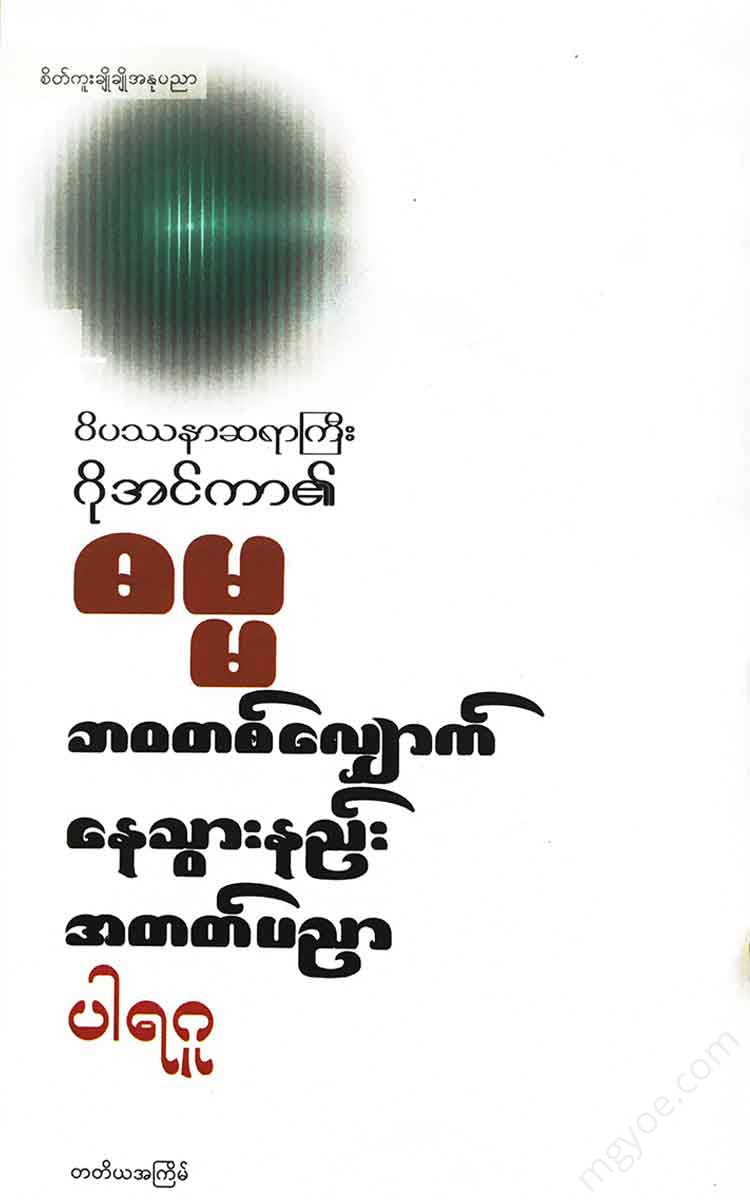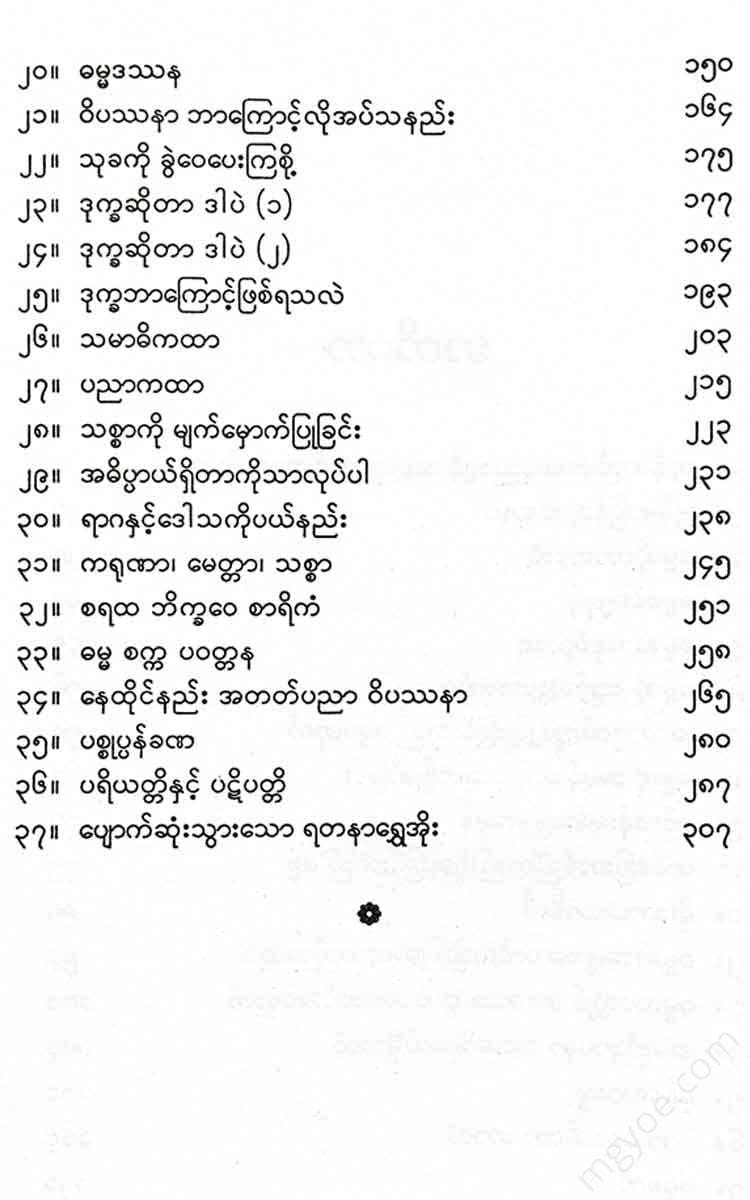စိတ်ကူးချိုချိုစာပေ
Expert - the art of living a virtuous life
Expert - the art of living a virtuous life
Couldn't load pickup availability
Merchant, literary scholar, artist, meditator
Just the other day, a monk came to my house. He asked for money to buy shoes. I didn't give him a single penny. This kind of monk often comes to my house. One person asks for books, another asks for robes, and another asks for travel expenses. I don't give a single penny to these kind of monks who ask for money for various reasons.
However, like those monks, I once went from house to house, accepting donations.
It was around 1952. One day, a certain U Pin Sin, holding a piece of paper in his hand, was going from one shop to another among the Indian merchants on Mughal Road and Merchant Street. The U Pin Sin first went into a Marathi cloth shop on the corner of Mughal Road and Merchant Street. When he got inside, he sat down in an empty chair in front of the headman’s table. The headman was a Marathi man of about thirty. The man looked up from his desk and saw a monk sitting in front of him.
"What's the matter?"
The monk handed him the paper that he had brought. The Maravari merchant, after reading the paper, without any further ado, wrote 50 next to his name on the paper and handed over fifty rupees. The monk was none other than him. He was the one who wrote this letter. The Maravari merchant was none other than him. He had gone through various stages of life, from being a successful merchant, a successful artist, a successful writer, and now, in India, he is a successful Vipassana master, a successful meditation teacher, and a successful Dharma guru, who is famous not only in India but also internationally.
The incident will need further explanation.
In 1947, I received the “Aryadharma Scholarship” and went to Varanasi University in India to teach Hindi and Sanskrit. The scholarship ended three years later in 1950. Although I had mastered Hindi and Sanskrit to a certain extent, my university education was not yet complete and I was still in a state of flux, so I could not return to Burma. However, since the scholarship was terminated, I needed money to continue living in India. My parents were manual laborers and could not support my education. My uncle, U Bo Thi, took over the responsibility and made it easier for me to continue my education.
However, in 1952, when I entered the secondary school, I unexpectedly failed the exam. I got a low grade in history. So, I stopped going to school and returned to Burma temporarily. If I stayed in India, it would be expensive. If I stayed in Burma temporarily, it would be cheaper. When the exam was over, I returned to India and took the second secondary school. With this intention, I returned to Burma.
After four or five months in Burma, when the time for the exams approached, I had to go to India for the second time to take the secondary school leaving exam. Here I had a problem with the travel expenses. My parents were also not financially well-off. My uncle was financially well-off, but I was reluctant to ask him for help again. If possible, I wanted to go to India at my own expense.
During that time, I had a conversation with an Indian friend. The Indian was an acquaintance of mine who I met on the street every day in Varanasi. At that time, the Indian was a member of the editorial staff of a Hindi daily newspaper called “Oj” published in Varanasi. His name was Mr. Sharmajang. When I returned, he was in Yangon. He was working as the editor of a Hindi daily newspaper called Prajipraka published in Yangon. In fact, Mr. Sharmajang had lived in Zayedda, Burma, even before the war. During the war, he served as a police officer in Zayedda during the Japanese occupation. When the Japanese invasion began, Mr. Sharmajang provided a lot of help to the revolutionaries. Comrade Mya described him as “a fascist.”
He is described in detail with a photo in the book "The Revolutionary People's Police and the Lost Guerrilla". After the war, he returned to India. He worked as a newspaper editor in Varanasi, India.
During that time, we became friends.
In the 1950s, he returned to Burma and took up the editorship of a Hindi daily published in Yangon. He then left the newspaper and served as the principal of Tagore College in Yangon. On the other hand, he was a special correspondent for Burma in the Hindi newspaper "Oj" in Varanasi, of which he was a member of the editorial board, and wrote a weekly column called "Letters from Burma". About five years ago, he returned to Burma permanently. Now, he has even resumed his editorial duties as a member of the editorial board of the newspaper "Sene" in Varanasi. He has handed over the "Letters from Burma" column to me.
When I was having trouble paying for my travel expenses to India to take the exam, my friend, the monk Shamarjan, helped me. He wrote on a piece of paper that he was studying Hindi and Sanskrit in Varanasi, that he had returned to Myanmar temporarily and was having trouble paying for his return to India, and that he would like to ask for help.
At the bottom of the letter, he wrote the names and addresses of about ten wealthy Marawari merchants he knew. I went out with this paper in my hand to receive the donation. The first person on the list of recipients of the donation written on the paper was Satuna Yangon Inka, whom I had first met.
There is a custom among Indians. When money is given, the first person to give it is usually followed by the next person. When Satnarayan Goenka, who is numbered (1) in my list of donors, contributed fifty rupees, the others did not complain and added fifty rupees each. In this way, I earned five hundred rupees in one day. Five hundred rupees was not a small amount in those days. With that five hundred rupees, I went to India. I reached Calcutta with about thirty-four rupees on the deck of the ship.
I returned from India around 1953. I changed my clothes around 1955. After that, I had studied Hindi in India and often met Satnarayan Goenka, a literary figure from the Marathi merchant community who loved Hindi literature. But he did not remember me donating fifty rupees. I did not tell him. Later, when he became the president of the Myanmar Hindi Literature Association and I became the vice-president, we became closer.
Satnarayan Goenka was born in Mandalay in 1924. His parents had migrated from Rajasthan, India, to Mandalay, Burma, long before the Second World War. His parents were cloth merchants. Before the war, he studied at DAV High School in Mandalay until the tenth grade. He did not go to university because of the outbreak of World War I. During the war, the family returned to India. After the war, they returned to Yangon. When they returned to Yangon after the war, their eldest son, Goenka, took over the family business. When the chief minister was appointed, the family business grew rapidly. He built a large building on Mughal Road.
Satnarayan Goenka became one of the most successful merchants of the Marawari people in Burma. He was a large-scale textile merchant. He had contacts with the major countries of the world. He himself often visited foreign countries. He also had many representatives in foreign countries. The Bandula silk, which was once popular in Burma, was his invention. The Bandula silk machine was a machine that he designed. He was not just a merchant who sat in a shop and sold goods. He created one business after another. After establishing the Bandula silk machine, he established a rice bran oil mill in Pathein. While developing one business after another, he was also involved in other social, religious and literary activities. He served as the President of the Marawari Chamber of Commerce. He was an executive member of the Indian Congress Association. He was also a member of the Burma Chamber of Commerce. He served as the Treasurer of the Gandhi Memorial Trust. The Hindu Central Association and other religious organizations are also not immune to his contributions.
His speciality was his love for literature and art. Among the Indian merchants in Yangon, he was the only one I had ever met who was interested in literature and art. He loved literature. He himself wrote. He composed poetry. Once he went to Russia as a member of a trade delegation from Burma. When he arrived in Russia, he composed a poem in Hindi and recited it on the Moscow Radio. When a merchant wrote such a high-level poem, everyone praised him.
He also served as the President of the Myanmar Hindi Literature Association for many years. During this time, he himself wrote school textbooks for use in Hindi schools in Myanmar. His Hindi textbooks are based on the Burmese environment and Burmese culture. On the one hand, he writes textbooks for Indian children, and on the other hand, he writes research papers. He has studied the history of the rise and spread of the Ramayana in Burma in detail and written a paper with a critical perspective. He has also made efforts to research other Burmese cultures and Burmese literature.
Satnarayan Goenka, in memory of his late father, had deposited twenty thousand rupees in the Ramakrishna Society for the purpose of literature. With this money, books were printed and distributed. In 1967, the Burma Hindi Literature Society, of which he was the president, had awarded me a gold medal. This gold medal was a gold medal prepared with money from that fund.
Satnarayan Goenka had not only literary talent but also artistic talent. He was one of the founders of the Burma Indian Art Society. He also served as its president. He financed and produced Indian artists in Burma. He led the Indian Art Society and used to perform plays in Rangoon on important occasions related to the Indian people. At that time, he himself acted as a director. He himself acted as an actor. I remember. Once, a historical play was performed. The story was about King Ashoka. In that play, he himself played the role of King Ashoka.









